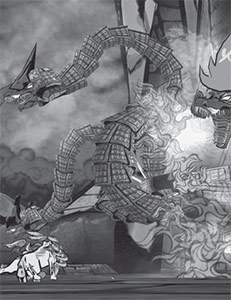Dig up some buried treasure
 CREDIT: PLATINUM GAMES
CREDIT: PLATINUM GAMESArguably inspired by Zelda, Okami HD's art style in turn inspired games like Street Fighter, Shadow of Colossus and ICO.
WESTMINSTER — When my friend told me I needed to play this Japanese action-adventure platformer called Okami HD, I thought I might as well try it because it was only $7 on the PlayStation Store.
Okami begins with a story. Set in Nippon, a white wolf named Shiranui and a swordsman named Nagi fight together to protect Kamiki Village from Orochi, an eight-headed demon. Failing this, they seal Orochi in the Moon Cave.
After 100 years, Susano, a descendant of Nagi, decides to try and prove that the legend was false. He releases Orochi and the lands are cursed again with monsters. A wood sprite named Sakuya summons the sun goddess Amaterasu, a reincarnation of the not-so-mythical white wolf, which you play as. She is later joined by Issun, a wandering artist, and together they try and stop Orochi once and for all. The story turns out to be much more than that.
The crazy part is that you learn all of that in the first hour of gameplay. It’s a huge story spanning dozens of humorous hours, great puzzles, and combat. To say this game is inspired by the Zelda series is an understatement.
Almost everything in this game reminds me of Zelda – except the Celestial Brush mechanic, which is where you hold down a button that pauses the game and a brush reveals itself to you, letting you manipulate the world around you in many various ways. As you go about your journey, you learn these different techniques from the Celestial gods (based on the Chinese zodiac), such as Divine Wind or Bloom. These in turn let you traverse the world even farther, collecting various Japanese treasures.
Everything and everyone in this game is based on Japanese folklore – even the title is a reference: “Okami” means “wolf” in Japanese. The game’s art style is unlike anything I’ve seen. Everything looks like it was colourfully hand-drawn. It emanated Japanese culture itself and I’ve actually learned a lot just by playing the game.
Every game has at least one flaw, however, and Okami is no different. There were a few cutscenes that really dragged on. On top of that, the speech throughout this game is literally just random noises created by scrambling samples of the voice actors’ speech. I just found that strange. I would’ve even preferred them to speak Japanese, at least then I could probably learn something more. Of course, those problems are almost nothing compared to how much you’re getting from the game.
I was extremely surprised when my friend told me that this game originally came out in 2006 for the PS2. Apparently a whole bunch of people, myself included, were playing games under a rock because at first the game didn’t sell very well. As the year went on, it somehow gained widespread popularity, becoming the second best PS2 game that year. After they made this game, Clover Studio became Platinum Games, which has made games like Bayonetta. I didn’t realize how many references there were from Okami in that game. I’m also surprised at how many games have been influenced by Okami’s art style, like Street Fighter, Shadow of the Colossus and ICO to name a few.
It doesn’t matter if you didn’t play Okami on your PS2 in 2006, your Wii in 2009, or in beautiful HD on the PS3 in 2012. You might be a bit late to the party, but it’ll be the best party you’ve been to in a long time.













